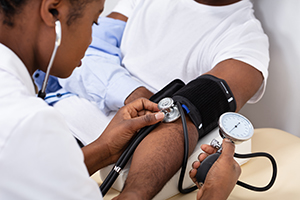January 2022 News Roundup
This month features polypharmacy and HF, a strange case of myocarditis induced by spider bite, zero-contrast PCI, and more.

Every month, Section Editor L.A. McKeown curates a roundup of recent news tidbits from journals and medical meetings around the globe.
The underrepresentation of women in cardiology procedural subspecialties, as well as leadership roles, results in less access to novel technology, according to a study in Heart Rhythm. Among early implanters of the Watchman device (Boston Scientific), only 2.9% were women. The likelihood of a woman implanting Watchman devices was highest at hospitals with a female in a leadership position, either in interventional cardiology or electrophysiology.
Patients who receive 1 month of dual antiplatelet therapy (DAPT) after PCI are not at increased risk of death, nonfatal MI, stroke, stent thrombosis, TVR, or major bleeding compared with those receiving DAPT for 3 months or more, according to a meta-analysis of 4 RCTs with more than 26,000 patients. Writing in the American Heart Journal, the authors conclude that newer-generation stents “probably play a role in mitigating the ischemic events after PCI (stent thrombosis, in-stent restenosis, and so on).”
 Polypharmacy contributes to a higher 1-year risk of death and rehospitalization, according to a study of patients who were discharged following a HF-related stay. The paper, in the Journal of Cardiovascular Nursing, advocates for collaborative disease management programs focused on reviewing medication lists, with a goal of getting the total number of prescriptions per patient under six.
Polypharmacy contributes to a higher 1-year risk of death and rehospitalization, according to a study of patients who were discharged following a HF-related stay. The paper, in the Journal of Cardiovascular Nursing, advocates for collaborative disease management programs focused on reviewing medication lists, with a goal of getting the total number of prescriptions per patient under six.
Rumors, hoaxes, and false theories about the COVID-19 virus and available vaccines “has shed new light on the importance of having credible sources of healthcare information and continuous monitoring of social media platforms to determine whether accurate information is being relayed to the public,” investigators write in a paper published in AIMS Public Health. Battling the massive COVID-19 “infodemic,” they say, will require collaboration among governments, law enforcement bodies, social media companies, community-based organizations, and other vital stakeholders.
In patients who have recovered from acute COVID-19 illness, minimally invasive assessment for biomarkers of myocardial injury, stretch, and coagulopathy may be helpful for early risk stratification, according to a meta-analysis published in IJC Heart & Vasculature. In pooled data from 62 studies, elevated biomarkers of inflammation, subclinical myocardial injury, and coagulation were frequently associated with severe COVID-19 illness and death.
 Writing in JACC: Case Reports, German investigators report the first known case of myocarditis related to a spider bite. Three days after being bitten on the thigh by a brown recluse spider, a 31-year-old man with no traditional cardiac risk factors was taken to the cath lab with atypical chest pain, elevated heart rate, fever, chills, diffuse ST-segment elevation on ECG, and elevated troponin. Diffuse nonobstructive coronary disease was found, which cardiac MRI further characterized as suspected myopericarditis. The symptoms resolved on their own, with transthoracic echocardiography at 3 weeks after discharge showing normalization of cardiac function.
Writing in JACC: Case Reports, German investigators report the first known case of myocarditis related to a spider bite. Three days after being bitten on the thigh by a brown recluse spider, a 31-year-old man with no traditional cardiac risk factors was taken to the cath lab with atypical chest pain, elevated heart rate, fever, chills, diffuse ST-segment elevation on ECG, and elevated troponin. Diffuse nonobstructive coronary disease was found, which cardiac MRI further characterized as suspected myopericarditis. The symptoms resolved on their own, with transthoracic echocardiography at 3 weeks after discharge showing normalization of cardiac function.
Also in JACC: Case Reports, a cath lab team from Mexico explains how they used 3D printing to create a test model to help them plan the closure of a “giant paravalvular leak” in a 72-year-old man. Following a practice run with the 3D model and the closure device, a successful procedure was carried out and the leak was completely sealed.
Sex- and race-specific pooled cohort equations, used to estimate individual 10-year risk of CVD can result in major differences in risk prediction for Black versus white individuals despite identical risk-factor profiles. In the Lancet Digital Health, researchers say the differences may be surrogates for structural racism, healthcare access, educational achievement, economic challenges, and other health inequities. They suggest that “race should be replaced in any risk prediction equation by the various potentially causal factors that race represents, and that can be targeted with interventions.” 
An article in the Methodist DeBakey Cardiovascular Journal describes the challenges and successes the hospital encountered when they were forced to transition their annual hands-on bootcamp for CV surgery and interventional cardiology trainees to a virtual event because of the COVID-19 pandemic. “Although it is impossible to replace the hands-on experience, we present an alternative learning platform that can bridge educational gaps when in-person training is not an option,” the authors write.
A small safety and feasibility study in the International Journal of Cardiology suggests zero-contrast PCI could be a reasonable option for select patients at risk for contrast-induced acute kidney injury. Using IVUS guidance alone, technical success was achieved in 87%. At 1 month, no patients developed MACCE and none required initiation of renal replacement therapy.
L.A. McKeown is a Senior Medical Journalist for TCTMD, the Section Editor of CV Team Forum, and Senior Medical…
Read Full Bio


Comments